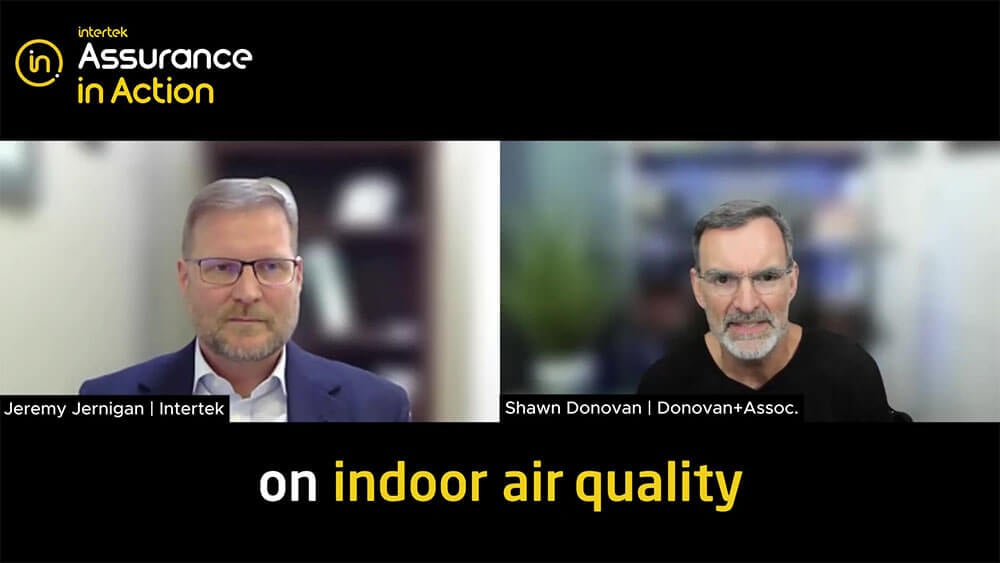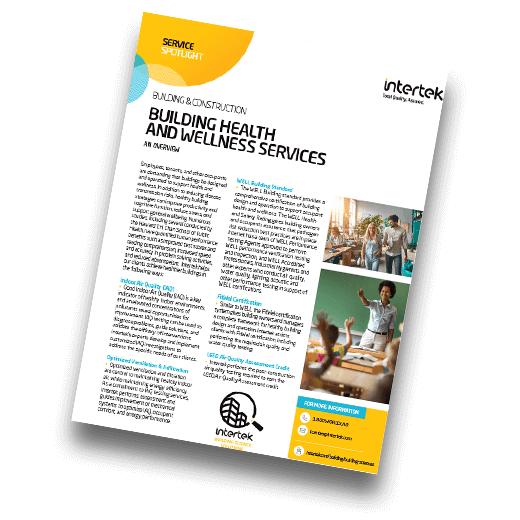Indoor Air Quality (IAQ) Solutions for Healthy Living, Working, and Learning Building Environments
Indoor Air Quality (IAQ) was an emerging concern to building owners, operators, managers, and tenants even before the global pandemic, and today the health implications of our indoor air are more relevant a topic than ever before. In schools, offices, multi-family buildings, hospitals, and healthcare facilities in particular, the public wants to be assured that their living, working, and learning environments are protected from environmental hazards and that steps have been taken to help reduce risks from airborne contaminants and support their general wellbeing.
Questionable environmental conditions and poor indoor air quality can cause health issues that include respiratory problems, headaches, cardiovascular problems, and cancers. These health and safety issues are concerning and ignoring them can carry major business consequences. Poor indoor air quality decreases worker productivity and increases stress, absenteeism, insurance costs, legal and financial liabilities, and the chances of forced downtime, and broken or strained lease agreements.
Common reasons for poor indoor air quality include inadequate or poor ventilation and filtration, excessive moisture, use of cleaning products, off-gassing from building materials and furnishings, poor maintenance of HVAC systems and local outdoor pollutants. As a result, these issues contribute to the buildup of indoor air pollutants and the spread of airborne agents like mold spores and other allergens, carbon monoxide, formaldehyde, radon, and volatile organic compounds (VOCs). According to the EPA, levels of indoor air pollutants are often 2 to 5 times higher than outdoor levels.
Depending on our findings, mitigation steps might include the removal of contamination sources, recommended changes to operational or maintenance practices, increased ventilation, improved filtration, and in some cases the addition of supplemental air cleaning devices.
Every building, building system component and air quality situation is unique, and ultimately hundreds of variables may need to be considered to effectively problem solve specific air quality concerns. Thankfully, Intertek’s team of architects, environmental engineers and industrial hygienists specialize in assessing indoor air quality issues and implementing custom, effective, cost-conscious solutions to maintain healthy indoor environments.
Intertek’s Indoor Air Quality (IAQ) audits, assessments, and investigations cover many parameters, including the following:
- Airborne Particulate Matter <10 microns (PM10) or PM2.5
- Volatile Organic Chemicals (VOCs)
- Combustion fumes (i.e., diesel and carbon monoxide)
- Mold (Fungi)
- Moisture
- Typical Comfort Parameters (Temperature, Relative Humidity, Carbon Dioxide, etc.)
- Additional Specialty Indoor Air Quality (IAQ) Solutions

Assurance in Action: Indoor Air Quality
Additional Specialty Indoor Air Quality (IAQ) Solutions
WELL Building Standard Certification
The WELL Building standard provides a comprehensive certification of building design and operation to support occupant health and wellness. The WELL Health and Safety Rating gives building owners and occupants assurance that pathogen risk reduction best practices are in place. Intertek has a team of WELL Performance Testing Agents approved to perform WELL performance verification testing and inspection, and WELL Accredited Professionals, Industrial Hygienists and other experts who conduct air quality, water quality, lighting, acoustic and other performance testing in support of WELL certifications.
FitWel Certification
Similar to WELL, the FitWel certification system gives building owners and managers a complete framework for healthy building design and operation. Intertek assists clients with attaining FitWel certification by performing the required air and water quality testing.
LEED Air Quality Assessments
Intertek’s Industrial Hygiene experts perform the post-construction air quality testing required to earn the LEED Air Quality Assessment credit. Intertek has a team of accredited professionals, Industrial Hygienists and other experts who conduct air quality and other performance testing in support of LEED certifications.
Indoor Air Quality (IAQ) Resources
- Services Spotlight - Building Health & Wellness Services
- On-demand Webinar - Managing Indoor Air Quality and Mitigating Occupational Exposure
- Blog - Reducing GHG Emissions in the Built Environment
- Blog - Building for Occupant Health and Wellbeing
Indoor Air Quality (IAQ) Frequently Asked Questions
A: Indoor air quality refers to the state of air inside of buildings and its impact on the health and comfort of occupants. According to the EPA, levels of indoor air pollutants are often 2 to 5 times higher than outdoor levels, and in some cases these levels can exceed 100 times that of outdoor levels of the same pollutants.
A: The science of indoor air quality is evolving. There are established standards that set minimum ventilation rates and recommend maximum concentrations of certain pollutants, focused on maintaining acceptable indoor air quality to protect human health. Recent studies have better quantified the impacts of pollutants on human health, comfort, and performance (e.g. cognitive function), defining new standards for optimal, not just acceptable, indoor air quality.
A: The four primary indoor air pollutants of concern in most buildings are carbon dioxide, particulate matter, volatile organic compounds, and ozone. Other pollutants of concern may include carbon monoxide in spaces with combustion equipment, mold in buildings with moisture issues, and radon in the lower floors of buildings in certain geographies where it is naturally present in soils.
A: Indoor air quality can be affected by the following factors:
- Ventilation rates – Poor ventilation leads to higher concentrations of indoor pollutants.
- Filtration – Lower efficiency filters do not remove fine particulate matter from outside air and recirculated air, poorly fit filters allow pollutant to bypass them without being captured, and infrequently maintained filters will clog and impede air flow resulting in poor ventilation.
- Outdoor air quality – Outdoor air pollutants from industry, traffic, wildfires, and other sources, if not removed by proper design and maintenance of HVAC systems, can result in poor indoor air quality.
- Indoor pollutant sources – Interior finishes (e.g. carpet and paint), fixtures and furniture (e.g. composite wood and upholstery), cleaning chemicals, and equipment (e.g. copy machines) can introduce pollutants to indoor air, including volatile organic compounds, formaldehyde, and ozone. Additionally, vacuum cleaners without highly efficient filters can re-suspend particulate matter and other pollutants that have settled in carpets.
- Indoor moisture – Water intrusion and interior condensation due to poorly designed or failed building enclosures, and interior leaks and condensation from plumbing and mechanical equipment can result in mold and mildew, which release spores that are allergens, respiratory irritants, and can lead to other more serious health impacts.
A: In existing buildings, treating IAQ issues begins with recognizing and evaluating specific pollutants of concern and the likely sources. Depending on the findings, recommended controls may include removal of pollutant sources, changes in operational practices, increased ventilation, improved filtration, and sometimes the addition of supplemental air cleaning devices. To avoid IAQ issues in new buildings, projects should include HVAC designed for enhanced IAQ, specification of healthier building materials and furniture, enclosure design to avoid moisture issues, and implementation of a construction indoor air quality management plan.
A: The primary causes of poor IAQ include:
- Inadequate design or poor maintenance of ventilation systems
- Inefficient or poorly maintained filters
- Local/regional outdoor air pollution
- Interior materials, equipment, and operation and maintenance practices that release pollutants
- Leaks and other indoor moisture control issues
Intertek-PSI's Industrial Hygiene Laboratory
Intertek-PSI's in-house Industrial Hygiene Laboratory resource and differentiator for our comprehensive suite of environmental services. Our lab offers a wide range of analytical services that are crucial for environmental and occupational health assessments. Accredited by NVLAP and AIHA LAP, our experienced team delivers precise results, enabling clients to mitigate risks and uphold environmental stewardship.
Knowledge Center
Building Health & Wellness: An Overview of Services
Acoustical Testing & Consulting Resources
Remote Pre Inspections for NFPA 80 / 101
Protek - Safety. Everywhere. Every Day
Fire Doors 101: Your Guide to Testing and Certification - Webinar Recording
Tornado Testing & Certification Requirements - Webinar Recording
Plumbing Products Testing & Certification - Webinar Recording
The Evolving Code Evaluation Process White Paper
Proposition 65 & the Furniture Industry Webinar Recording
Why Planning for FCC Certification is Key to Success in the Door Hardware Industry White Paper

Upcoming Tradeshows & Events
Resources
- Search and Buy Building & Construction Standards
- SpecDirect
- Building Products Directory
- Project Connect (formerly myATI) – B&C Products
- Construction Hive – B&C Projects (PSIQest)
- My TestCentral



